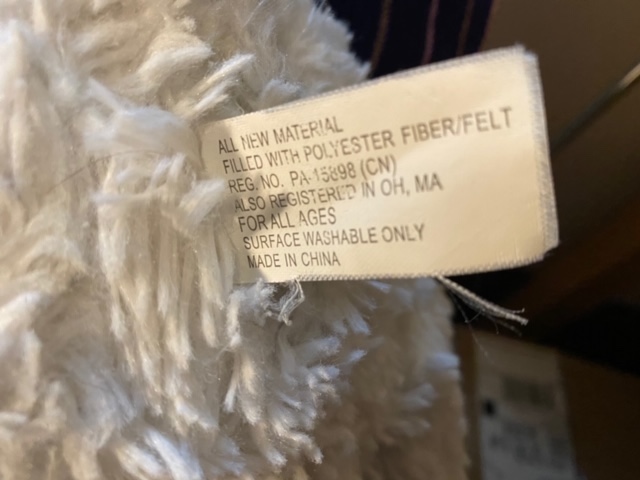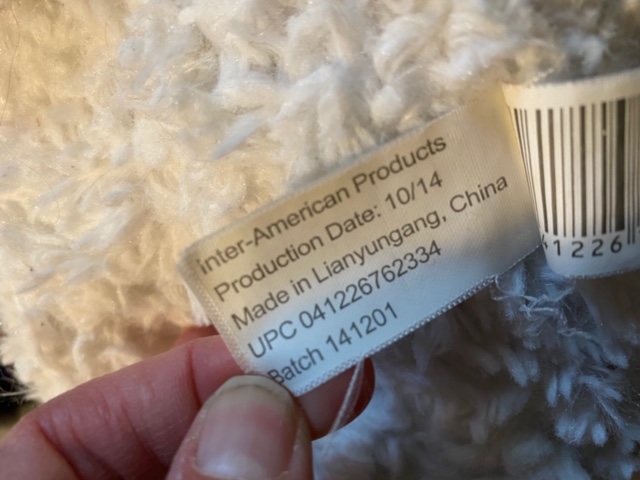2014 Stuffed Bunny Easter toy by Inter-American Products: 128 ppm Antimony (causes cancer in rats)
For those new to this website:
Tamara Rubin is a multiple-federal-award-winning independent advocate for childhood Lead poisoning prevention and consumer goods safety, and a documentary filmmaker. She is also a mother of Lead-poisoned children (two of her sons were acutely Lead-poisoned in 2005). Since 2009, Tamara has been using XRF technology (a scientific method used by the U.S. Consumer Product Safety Commission) to test consumer goods for toxicants (specifically heavy metals — including Lead, Cadmium, Mercury, Antimony, and Arsenic). All test results reported on this website are science-based, accurate, and replicable. Items are tested multiple times to confirm the test results for each component tested. Tamara’s work was featured in Consumer Reports Magazine in February of 2023 (March 2023 print edition).
Published: Tuesday, April 21, 2020
When tested with a high-precision XRF instrument (specifically designed for testing consumer goods for heavy metals), the stuffed bunny pictured here (purchased in 2014, I believe, at a Walgreens) had the readings listed below. Antimony is a heavy metal often found as a component in flame-retardants; however, when it is an intentional addition in flame-retardants, the levels found are usually much higher than what was found in this bunny (generally in the 1,000 to 3,000 ppm range — like with this mattress).
How much Antimony is “too much” Antimony?
The “International Antimony Association” assures consumers (in their public statements) that the low levels of Antimony I am consistently finding in most conventional plastic food packing (for example plastic peanut butter jars) and in most conventional (non-organic) stuffed animals and beddings made with synthetic fabrics (mattresses, pillows, sheets, blankets, pajamas, etc.) is completely safe. However, Antimony exposure has been definitively shown to have a causal linked to cancer in rats. Studies of persistent/ chronic low-level Antimony exposure in humans have also demonstrated correlative (and potentially causal) breathing complications and other issues. Many other significant human health impacts have been observed when looking at levels typical of industrial exposures to Antimony (for those who work with Antimony or Antimony containing products). It has been, in large part, due to the potential health impacts of toxicants used in flame-retardants (including Antimony) that environmental activists have seen significant success in getting flame-retardants removed from many home goods in markets across the country. YET trace levels of Antimony are still found consistently across the board in fabrics and fillings that have not been treated with flame retardants.
But really, is this an issue for me?
I have been doing home visits with families across the country for more than a decade now. In the past 4 years more and more families will have urine panels, blood tests, or hair tests done before my visits. In the test results that show full heavy metal panels, I am OFTEN seeing elevated levels of Antimony, with some being “off the charts” — literally (the line extends as far as it can go with the limitations of the heavy metal graphs). Said another way, children across America are testing positive for Antimony in their blood, urine, and hair. These children have not had “industrial exposures.” These children do not have parents who work in a related industry. These are typical American children. Where is the Antimony coming from then? Their stuffed animals, bedding, mattresses, couches, their jammies, and their peanut butter jars. One source of incidental exposure MAY be fine but kids today are being bombarded with Antimony (albeit at low levels) from every source imaginable. These trace levels add up in the body, especially when there are sources that are in regular contact with a child’s food, their mouth (like a stuffed animal they might suck or nibble on), or naked body (like pajamas).
What should I do with this information?
It is for the reasons noted above that I discourage letting young children (or any children for that matter) sleep with conventional “stuffies” — especially ones with poly-fil, which may be higher in Antimony (generally in the 150 to 300 ppm range). If you know your child will be sleeping with (or sucking on, or snuggling with) a stuffed animal or other type of stuffed toy or blankie, please do your best to guide them in their choice of a favorite snuggly (preferably guiding them to a choice made of organic cotton, wool, or other similar natural fibers, and preferably dyed with natural [vegetable-based] dyes, as well).
Full XRF Test Results for the Bunny Pictured
White of Belly — 120-second test:
- Antimony (Sb): 106 +/- 32 ppm
- Bromine (Br): 47 +/- 8 ppm
- Selenium (Se): 36 +’- 11 ppm
- Copper (Cu): 98 +/- 28 ppm
- Iron (Fe): 285 +/- 88 ppm
- Titanium (Ti): 29,900 +/- 700 ppm
- Chlorine (Cl): 666 +/- 392 ppm
Pink of Nose — 60-second test:
- Antimony (Sb): 128 +/- 53 ppm
- Iron (Fe): 240 +/- 80 ppm
- Titanium (Ti): 3,304 +/- 134 ppm
- Chlorine (Cl): 550 +/- 301 ppm
Pink of Ears — 60-second test:
- Antimony (Sb): 123 +/- 59 ppm
- Titanium (Ti): 3,107 +/- 163 ppm
Plastic Eyeballs — 60-second test:
- Titanium (Ti): 31 +/- 15 ppm
Pink Bow — 60-second test:
- Iron (Fe): 126 +/- 50 ppm
- Titanium (Ti): 48 +/- 29 ppm
- Chlorine (Cl): 420 +/- 265 ppm
Some additional reading that may interest those reading:
- How Lead Safe Mama performs the testing we conduct and report on here on the website.
- Some bedding that tested positive for Antimony.
- My “Chip-in” link if you would like to support the work here on LeadSafeMama.com.
- Here’s how to participate in the testing we do.
As always, thank you for reading and sharing this work.
Please let me know if you have any questions.
Tamara Rubin
#LeadSafeMama

Never Miss an Important Article Again!
Join our Email List












Hi Tamara, I wasn’t sure where to ask this questions, so when I went to your page and saw this post I thought it might be okay here. My son tested positive a few years ago for lead 1-2 in a blood test, but the doctors didn’t act concerned. He is 4 1/2 years old now and we just did a hair test where it came back he had high levels of antimony, aluminum, and arsenic with his lead level being .6. Now we have been aware of the lead situation these last few years and have tried to decrease his exposure, but then these other metals came up, so what would you suggest to do? My youngest son (1 1/2 also came back with similar readings, his lead was a little higher, but the antimony and others were just as high. I had no idea about flame retardants and everything involved with the possible exposure. Where should I start? Everything polyester should go including mattresses, bedding, toys, etc? Or should we look at our carpet which I also read likely has antimony? I was also tested and my hair sample came back with minimal heavy metals, but my absorption of minerals was off the charts low which someone suggested mercury that may not come up on the hair test? Why would me and my kids have such differences with the antimony, aluminum, and arsenic? Also, some people have suggested my oldest son might be exhibiting signs of ADD or hyperactivity…..I’m not a doctor, so I don’t know, but could levels of this nature cause this and what should I do? Thank you for your time.
This is a very interesting post and relevant to my current situation. I’m struggling to find baby products (play mats, bouncer chairs, mattresses, etc) that are completely made of organic non toxic material and are within my budget. Do you have any recommendations for parents in this situation?
To elaborate, almost every nursing pillow, baby lounger, and baby bouncer, baby mat have a polyester filling (even when the outer cover is organic cotton). Do you think that is a problem too? The few ones in the market without polyester get extremely expensive and I believe are out of budget for most parents.